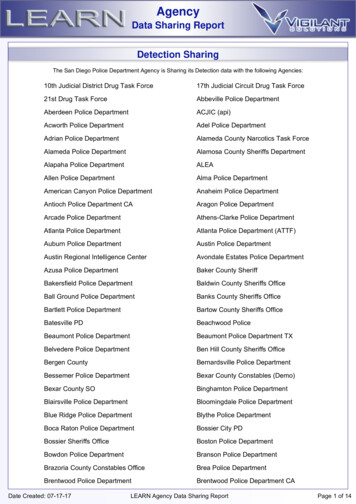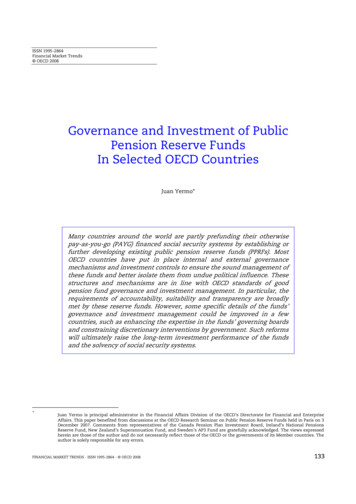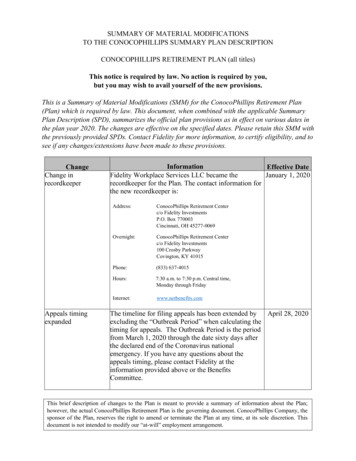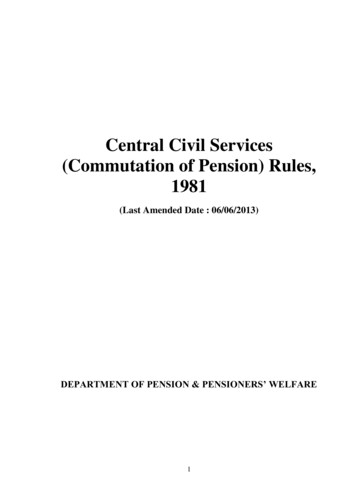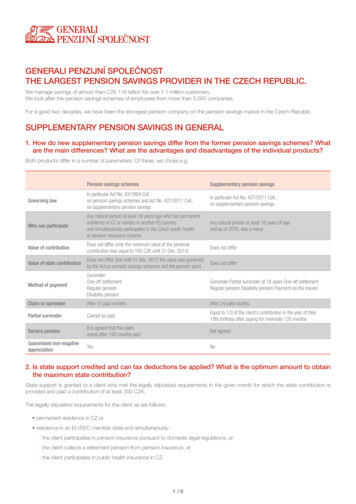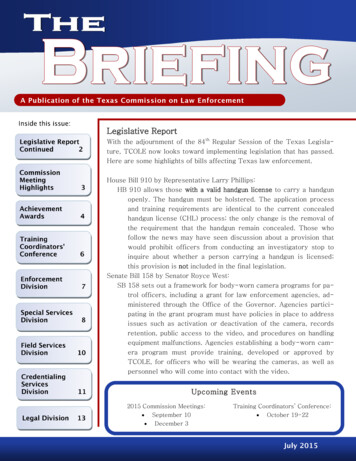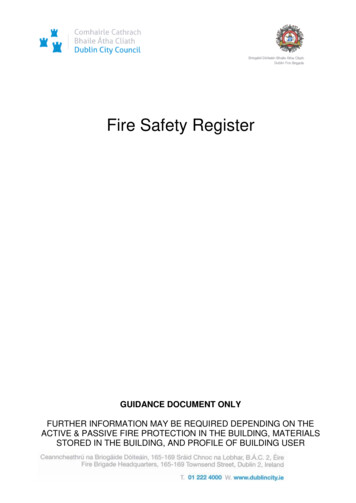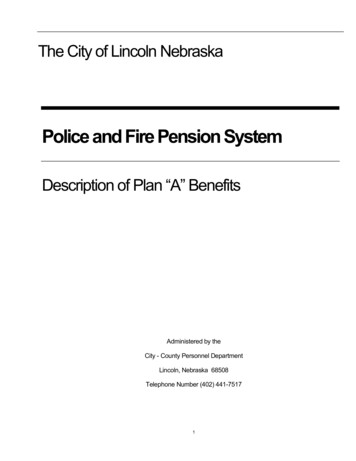
Transcription
The City of Lincoln NebraskaPolice and Fire Pension SystemDescription of Plan “A” BenefitsAdministered by theCity - County Personnel DepartmentLincoln, Nebraska 68508Telephone Number (402) 441-75171
Table of ContentsTHE BASICS OF POLICE AND FIRE PENSION PLAN "A"5I.INTRODUCTION6II.REPORTING TO MEMBERS6A. ANNUAL REPORTINGB. MEMBER REQUESTED REPORTING77CONTRIBUTION8A. EMPLOYEE CONTRIBUTIONB. EMPLOYEE CONTRIBUTION AND MILITARY LEAVEC. TAXPAYER D.10101011GENERALRATE OF RETURNINVESTMENT BOARDINVESTMENT POLICYNON-VESTED SEPARATION BENEFITS12A. ELIGIBILITYB. BENEFITSC. TAXABILITY121212DEFERRED ANNUITY ILITYRETURN OF ACCOUNT VALUEPARTIAL ANNUITY BENEFITS162
URN OF ACCOUNT VALUE16161818AGE AND SERVICE RETIREMENT ILITYRETURN OF ACCOUNT VALUEDISABILITY RETIREMENT BENEFITS22A. DUTY-RELATED TEMPORARY TOTAL DISABILITY (INJURY LEAVE)B. DUTY RELATED PERMANENT TOTAL DISABILITYC. NON-DUTY RELATED PERMANENT DISABILITYD. REVIEW OF DISABILITY RETIREMENTE. TAXABILITYF. RETURN OF ACCOUNT VALUE222324252626SURVIVOR BENEFITS27A.MEMBER’S DEATH OCCURS AFTER THE MEMBER STARTED RECEIVING PARTIAL ANNUITYBENEFITS, OR AGE AND SERVICE RETIREMENT BENEFITS.B. MEMBER’S DEATH OCCURS AFTER THE MEMBER STARTED RECEIVING DISABILITY RETIREMENTBENEFITS.1. SPOUSE AS SURVIVOR BENEFICIARY2. NON-SPOUSE AS SURVIVOR BENEFICIARY3. NO SURVIVOR BENEFICIARYC. MEMBER’S DEATH IS CAUSED BY INJURY INCURRED IN THE LINE OF DUTY.1. SPOUSE AS SURVIVOR BENEFICIARY2. NON-SPOUSE AS SURVIVOR BENEFICIARY3. NO SURVIVOR BENEFICIARYD. MEMBER’S DEATH IS CAUSED BY INJURY OR ILLNESS NOT INCURRED IN THE LINE OF DUTY.1. SPOUSE AS SURVIVOR BENEFICIARY2. NON-SPOUSE AS SURVIVOR BENEFICIARY3. NO SURVIVOR BENEFICIARYE. TAXABILITYF. RETURN OF ACCOUNT VALUE2727282828282829292929303030XI.DISCHARGE BENEFITS31XII.TAX REPORTING31273
XIII.RETURN OF ACCOUNT VALUE33XIV.GENERAL PROVISIONS35A. MILITARY LEAVEB. ASSIGNMENTC. RE-EMPLOYMENTD. MINIMUM MONTHLY BENEFITE. MENTAL INCAPACITYF. INVESTMENT BOARDG. SICK LEAVE PROVISIONS3535353535363613TH CHECK TO COMBAT INFLATION37A. AGE AND SERVICE OR DUTY DISABILITY RETIRANTSB. DEFERRED ANNUITY, PARTIAL ANNUITY , OR NON-DUTY DISABILITY RETIRANTS3737XVI.FIRE SERVICE EMPLOYEE COLA PURCHASE37XVII.SERVICE CREDIT PURCHASE37XV.4
The Basics of Police and Fire Pension Plan "A"Base PaySum of Hourly, Shift, and Longevity Pay.Employee Contributions8% of base pay for entire career.Average Monthly Base PaySum of highest consecutive 26 bi-weekly base pay amountsdivided by 364 days, multiplied by 365.25 days, then dividedby 12 months.Non-vested Separation(less than 10 years of service)Upon separation the member is refunded their contributionsand interest.Deferred or Partial Annuity(10 or more years of service,but not eligible for retirement)Beginning at age 50 the member is paid a monthly pensionequal to 64% of average monthly base pay multiplied by theratio of completed years of service to 25 years.Early Retirement(21 years of service and age 50)Beginning at early retirement date the member is paid amonthly pension equal to 64% of average monthly base paymultiplied by the ratio of completed years of service to 25years. (21/25 * 64% 53.76%)Regular Retirement(25 years service and age 50)Beginning at retirement date the member is paid a monthlypension equal to 64% of average monthly base pay.Duty DisabilityUpon Mayoral determination of duty disability the member ispaid a monthly pension equal to 58% of the member’saverage monthly base pay.Duty DeathUpon Mayoral determination of duty death the member'sspouse is paid a monthly pension equal to 58% of themember’s average monthly base pay.Non-Duty DisabilityUpon Mayoral determination of non-duty disability themember is paid a % of the member’s average monthly basepay determined by years of service (YOS): 0 to 5 YOS: 0% 5 to 10 YOS: 23% 10 to 15 YOS: 39% 15 or more YOS: 53%Upon Mayoral determination of non-duty disability themember’s spouse is paid a % of the member’s averagemonthly base salary determined by years of service (YOS): 0 to 5 YOS: 0% 5 to 10 YOS: 23% 10 to 15 YOS: 39% 15 or more YOS: 53%Police & FireNon-Duty Death5
Pension PlanI.INTRODUCTIONThe Police and Fire Pension is a defined benefit pension system providing retirement,disability and survivor benefits for Police Officers, Fire Fighters and their beneficiaries. Thesystem operates under the rules of Internal Revenue Code section 401(a).The Fire Pension was established in 1895. In 1947, it closed to new members and the Policeand Fire Pension was established. Members contributed 7% of salary on a "Post-tax" basis.Post-tax contributions are included in taxable income. In 1975, members were eligible fornormal retirement after 21 years of service and age 55. The normal retirement benefit was50% of the monthly average of the last five years wage with an additional 2% for each extrayear worked, up to a maximum of 60%. Members could choose the Straight Life paymentoption or one of two actuarially reduced payment options to include a beneficiary. Membersalso had the choice of receiving a refund (of their accumulated contributions and interest) andan actuarially reduced monthly benefit. In 1981, normal retirement benefits increased from50% to 54%, the maximum increased to 64% at age 60 and 26 years of service, and monthlyaverage base pay was changed to be based on the last three years’ salary. In 1984,members were given the choice of continuing to contribute 7% (Plan C) or switching to a newplan (Plan B) with a 7.6% contribution rate, a 58% normal retirement benefit and a 68%maximum benefit at age 60 and 26 years of service. New members were enrolled in the7.6% plan.In 1990, the pension system applied for and received Internal Revenue Service tax-qualifiedstatus. This means member contributions are “Pre-tax” and therefore not included in themember’s taxable income. Also in 1990, the normal retirement age was decreased from 55to 53 and pension benefits were based on a member's highest consecutive 26 biweekly payperiods (about 1 year) rather than last three years' salary.In 1995, members were given another opportunity to switch to a new plan. Members couldchoose to: 1) remain in their current plan, 2) switch to an enhanced version of their currentplan offering the same benefits, but not requiring contributions after 21 years of service, or 3)switch to a new 8% plan (Plan A). Plan “A” provides a 64% retirement benefit at age 50 and25 years of service, for an 8% contribution rate.This brochure explains Plan A. Police Officers and Fire Fighters hired after April 1, 1995 areenrolled in Plan A. City of Lincoln Municipal Code (LMC) Chapter 2.62 is the legal descriptionof Plan A and is available on the City’s Internet site. In the case of a difference between thisbrochure and Lincoln Municipal Code, Lincoln Municipal Code controls.II.REPORTING TO MEMBERSThe pension sends information to each of its members shortly after each calendar year end.Members can also obtain information on their pension benefits at any time from PensionAdministration. Also, every three months pension administration reports to the Police andFire Pension Investment Board.6
A. Annual ReportingThe information sent to each member shortly after the calendar year end includes: An account statement showing the member’s contributions and interest. A letter highlighting the past year’s activity. A summary of the pension system’s actuarial valuation, assets, and benefit provisions. An individualized Normal Age and Service Retirement benefit estimate. The benefitestimate uses a separation date equal to the date the member is assumed to attain age50 and 25 years of service, or the prior calendar year end date if the member has alreadypassed the age and service requirement.B. Member Requested ReportingMembers may request a free pension benefit estimate at any time from PensionAdministration. Estimates are available for all separation types and future dates. Theestimate increases the member's current Regular Pay by 3% annually, unless anotherpercent or override Regular Pay amount is input to the estimate request screen.7
III.CONTRIBUTIONPension members, and City of Lincoln taxpayers contribute to fund pension benefits.Pension members contribute through payroll deduction. City of Lincoln taxpayers contributethrough real estate property tax.A. Employee ContributionMembers contribute 8% of their base pay each pay period.Base Pay is:Hourly Pay Longevity Pay Shift Differential PayOut-of-grade pay (if any) is entered as hourly pay by the member’s department and thereforeis included in base pay. For contribution purposes, base pay does not include any other formof pay or benefit. For purposes of calculating average monthly pay, base pay includes PostEmployment Health Plan (universal) contributions and is adjusted for workers compensationpayments.When a member receives worker’s compensation pay, nopension contribution is deducted from it. For member’sseparating employment a manual adjustment is made to theirRegular Pay increasing it to what their pay would have been, sotheir pension is not reduced due to their compensable injury.Employee contributions to the pension before July of 1990 were "Post-tax.” Post-taxcontributions were included in the member’s taxable income. In July of 1990, the pensionsystem applied for and received Internal Revenue Service tax-qualified status. After receiptof tax-qualified status, member contributions were "Pre-tax.” Pre-tax contributions are notincluded as taxable income in the year they are contributed. Taxation on these contributionsis deferred until they are paid to the member.Each dollar a member contributes to the pension decreases the member’staxable income by a dollar.Another tax benefit is earning interest tax deferred. Both contributions and interest earninterest tax deferred, as long as the member is a Police Officer or Firefighter. Each member’scontributions and interest are placed in his or her individual pension account.8
B. Employee Contribution and Military LeaveA member may leave their job to serve in the U.S. Military in time of war or nationalemergency. Up to 4 years of military service count as time on the job if the member returnsto their job no later than 90 days after their military discharge date and works for one or moreyears. The City may require these members to contribute 3% of their base pay for each yearof military service credit granted to them. Contributions of this type are based on themember’s base pay at the time they began military service and can not exceed 2,500 perservice year.C. Taxpayer ContributionEach year, an independent actuarial firm determines the pension’s financial strength andliability for current and expected future pension payments. The taxpayer contribution to thepension fund is based on the actuarial analysis.Real estate property tax is collected according to the City’s budgeted pension contribution.The pension fund is credited with tax revenue as it is collected.9
IV.INVESTMENTSA. GeneralLincoln Municipal Code states pension investments are to be used only for legitimateobligations of the pension plan. Pension money could never be used for non-pensionpurposes, even if the City promised to re-pay the money with interest.Pension investments consist of debt and equity assets. Equity assets represent ownership.Equity assets include, but are not limited to, domestic and foreign common stocks or fundscontaining these types of stocks. Debt assets represent loans. Debt assets could include,but are not limited to, U.S. Treasury and U.S. Agency bonds, corporate bonds and mortgagebacked securities (such as bundles of home loans) or funds containing these types ofsecurities.Proceeds from the sale of securities, maturing debt securities, interest, dividends and capitalgains are combined with employee and taxpayer contributions to pay pension benefits andexpenses.B. Rate of ReturnEach month the market value of the assets in the pension fund is calculated. Change inmarket value, interest, dividends and realized gains are used to calculate a return rate whichis credited monthly to each member’s individual pension account. This means the returncredited to member accounts will fluctuate up and down.C. Investment BoardThe Board consists of nine members. Three appointed representatives of the City Council,two elected representatives of the Police Department, two elected representatives of the FireDepartment, the Human Resources Director (Pension Administrator) and the FinanceDirector.The Board oversees and directs plan investments with the advice of a professionalinvestment advisor. They usually meet in February, May, August and November. The Boardis informed of recent events, presented with information regarding plan assets, and ispresented with recommendations for plan’s investments.10
D. Investment PolicyThe Board developed the pension’s Investment Policy Statement. The policy states rules forinvesting and asset allocation given the plan’s investment objectives. Below is an excerpt.City of LincolnPolice and Fire PensionInvestment Policy StatementI.Investment ObjectivesThe objective of investing the assets of the Plan is to grow the assets over timeat a compound rate of increase that, together with contributions, will provide ahigh probability of payment of benefits according to the terms of the Plan. Thecompound rate of increase is defined as the Actuarial Assumed Rate of Return,as set forth in the Investment Strategy. The Board recognizes that the ActuarialAssumed Rate of Return objective is long term in nature, and that actual year-toyear returns achieved may be above or below the long-term target.The Board further expects the investments to provide a competitive return relativeto other investments available that would meet the Asset Allocation Strategy, asdefined below.II.III.IV.V.VI.ResponsibilitiesAsset Allocation StrategyInvestment GuidelinesInvestment Manager Selection GuidelinesReview StandardsThe complete Investment Policy is available online.11
V.NON-VESTED SEPARATION BENEFITSA. EligibilityMembers vest (become eligible for the City portion of pension benefits) after 10 years ofservice. If a member resigns, or is terminated, before completing 10 years of service he orshe is eligible for non-vested separation benefits.B. BenefitsNon-vested members are eligible to receive a refund of their accumulated contributions andearnings, but are not eligible to receive any current or future City funded monthly pensionbenefit.Upon separation, a member will receive a refund of his or her contributions, and earnings tohis or her separation date. The member has the distribution choices listed below.1. Receive a Direct Refund (a check made payable to the member) of all Pre-tax andPost-tax (if any) contributions and interest less 20% Federal Tax withholding. Nexttax filing the member will owe a 10% tax penalty to the IRS on the total amount ofPre-tax contributions and interest.2. Trustee Transfer the Pre-tax portion of the member’s contributions and all interest tothe financial institution designated by the member for deposit to the member’s IRA.Post-tax contributions (if any) will be refunded directly to the member.3. Receive a combination of a Direct Refund and a Trustee Transfer. The memberwould instruct Pension Administration regarding the amount to Trustee Transfer andthe amount he or she wants to receive as a Direct Refund.When members separate, their department notifies the Pension Administration and PensionAdministration contacts the member to discuss their pension payout options and give themthe form(s) they need to complete.C. TaxabilityPlease contact Pension Administration for a U.S. Treasury Tax Notice detailing the taxabilityof the three choices listed above. Also, please note that Pension Administration must reporta member’s refund decision, and amounts involved, to the Internal Revenue Service. We willmail the member an IRS form 1099-Misc. This form is mailed in January of the calendar yearfollowing of the pension refund. To assure receipt of this form, please remember to leave aforwarding address with the U.S. Postal Service and/or contact Pension Administration withyour new address.12
VI.DEFERRED ANNUITY BENEFITSA. EligibilityMembers vest (become eligible for the City portion of pension benefits) after 10 years ofservice. If a member resigns or is terminated after completing 10 years of service and hasnot attained age 50 he or she is entitled to deferred annuity benefits.B. BenefitsThe member’s benefit percentage is calculated by dividing the member’s years of service by25 (not to exceed 25/25) and then multiplying by 64%. Benefit percents are pro-rated toprovide members credit for partial years of service.For example:YEARS OF SERVICE10 Years 137 Days11 Years 20 Years21 Years .25 Years26 YearsBENEFIT PERCENT CALCULATION(10.375/25)*64%(11/25)*64%BENEFIT 76%(25/25)(26/25)*64%*64%64.00%64.00%Members choose from three payment type options.Payment TypeStraight LifeDescriptionMember receives a retirement benefit for life. At member's deathpayments stop.100% Survivor OptionMember is paid a reduced pension.At death, 100% of the reduced pension is continued for the life of themember’s beneficiary.50% Survivor OptionMember is paid a reduced pension.At death, 50% of the reduced pension is continued for the life of themember’s beneficiary.Monthly benefit beneficiaries must be a natural person with an insurable interest in thepension member.13
A refund of contributions and interest is not available on the member’s separation date, butupon separation the member is given a written guarantee his or her contributions and interestwill be returned to them, a designated beneficiary or the member’s estate. Please refer tothe RETURN OF ACCOUNT VALUE section of this brochure for details.Monthly benefit payments begin when the member attains age 50. Pension Administrationwill attempt to contact the member beginning sixty days before his or her fiftieth birthday toset up direct deposit and tax withholding. Once benefit payments begin, they are paid inarrears on the last working day of each month.Below is an example of Deferred Annuity Benefits:14
C. TaxabilityFor details, please refer to the TAX REPORTING section of this brochure.D. Return of Account ValueFor details, please refer to the RETURN OF ACCOUNT VALUE section of this brochure.15
VII.PARTIAL ANNUITY BENEFITSA. EligibilityMembers vest (become eligible for the City portion of pension benefits) after 10 years ofservice. If a member resigns or is terminated after completing 10 years of service and hasattained age 50 he or she is entitled to partial annuity benefits.B. BenefitsThe member’s benefit percentage is calculated by dividing the member’s years of service by25 (not to exceed 25/25) and then multiplying by 64%. Benefit percents are pro-rated toprovide members credit for partial years of service.For example:YEARS OF SERVICE10.37511 2021 .2526BENEFIT PERCENT CALCULATION(10.375/25)*64%(11/25)*64%BENEFIT 76%(25/25)(26/25)*64%*64%64.00%64.00%Members choose from three payment type options.Payment TypeStraight LifeDescriptionMember receives a retirement benefit for life.At member's death payments stop.100% Survivor OptionMember is paid a reduced pension.At death, 100% of the reduced pension iscontinued for the life of the member’sbeneficiary.50% Survivor OptionMember is paid a reduced pension.At death, 50% of the reduced pension iscontinued for the life of the member’sbeneficiary.Monthly benefit beneficiaries must be a natural person with an insurable interest in thepension member.16
A refund of contributions and interest is not available on the member’s separation date, butupon separation the member is given a written guarantee that his or her contributions andinterest will be returned to them, a designated beneficiary or the member’s estate. Pleaserefer to the RETURN OF ACCOUNT VALUE section of this brochure for details.Monthly benefit payments begin when the member separates service. Once benefitpayments begin, they are paid in arrears on the last working day of each month.Below is an example of Partial Annuity Benefits:17
C. TaxabilityFor details, please refer to the TAX REPORTING section of this brochure.D. Return of Account ValueFor details, please refer to the RETURN OF ACCOUNT VALUE section of this brochure.18
VIII.AGE AND SERVICE RETIREMENT BENEFITSA. EligibilityMembers become eligible for early age and service retirement benefits after completing 21years of service and attaining age 50. Normal age and service retirement benefits areavailable after completing 25 years of service and attaining age 50.B. BenefitsThe member’s retirement benefit percent is calculated by dividing the member’s number ofyears of service by 25, (not to exceed 25/25) and multiplying the result by 64%. (Benefitpercents are pro-rated to provide members credit for partial years of service.)For example:Years ofServiceAge2150 2250 2350 2450 2550 2650 Benefit %(24/25)*64%(25/25)*64%(25/25)*64%Benefit Percent53.76%56.32%58.80%61.44%64.00%64.00%Monthly payments begin as soon as the member retires. Once benefit payments begin, theyare paid in arrears on the last working day of each month.Members choose from three payment type options.Payment TypeStraight LifeDescriptionMember receives a retirement benefit for life. At member's deathpayments stop.100% Survivor OptionMember is paid a reduced pension.At death, 100% of the reduced pension is continued for the life of themember’s beneficiary.50% Survivor OptionMember is paid a reduced pension.At death, 50% of the reduced pension is continued for the life of themember’s beneficiary.Monthly benefit beneficiaries must be a natural person with an insurable interest in thepension member.19
A refund of contributions and interest is not available on the member’s retirement date, buthis or her contributions and interest are guaranteed to be returned in full. Please refer to the“RETURN OF ACCOUNT VALUE” section of this brochure for details.Below is an example of Age and Service Retirement Benefits:20
C. TaxabilityFor details, please refer to the TAX REPORTING section of this brochure.D. Return of Account ValueFor details, please refer to the RETURN OF ACCOUNT VALUE section of this brochure.21
IX.DISABILITY RETIREMENT BENEFITSA. Duty-Related Temporary Total Disability (Injury Leave)If a member is injured in the line of duty, independent of the injury occurring during themember’s duty shift or the member’s own time, the member may be eligible to receive DutyRelated Temporary Total Disability benefits. To be eligible for benefits the member must bedetermined to be temporarily totally disabled (TTD) by a medical doctor.Injury leave benefits apply for a period of up to Six months after the date ofinjury. The standard Six-month period can be extended by the HumanResources Director with the member’s accumulated sick leave as long as themember is determined to be TTD by a medical doctor.Benefits will equal the amount of the member’s salary and earned fringe benefits, as if themember were working their normal full time position. The pension system has noinvolvement in determining if these benefits should be paid to the member.To receive benefits, a workers compensation claim must be on file with the City's HumanResources Department Risk Management Division. The lesser of two-thirds, or theallowable legal maximum, of the payment is a workers compensation payment, and thereforeis not taxable.When a member receives worker’s compensation pay, no pension contribution is deductedfrom it. For member’s separating employment a manual adjustment is made to their RegularPay increasing it to what their pay would have been, so their pension is not reduced due totheir compensable injury.If the member believes they will not be able to return to duty at the end of the six-monthperiod (plus any sick leave derived extensions), the member should apply for a disabilitypension. Disability pension applications usually take 2 -3 months to process. If, during theperiod of time when the member is receiving injury leave, the disability is determined to bePermanent and Total (i.e. the disability application was approved by the Mayor), DutyRelated Temporary Total Disability benefits will cease and Duty-Related Permanent TotalDisability benefits will begin.If the member does not return to duty at the end of the six month period (plus any sick leavederived extensions) and has not been granted a disability pension, they may be able toreceive workers compensation payments until their disability pension (if any) begins.22
B. Duty Related Permanent Total DisabilityIf a member is injured in the line of duty, independent of the injury occurring during themember’s duty shift or the member’s own time, and if the injury is determined to bePermanent and Total, the member is eligible to receive Duty Related Permanent TotalDisability benefits.If a member is eligible for retirement, Age andService Retirement benefits should becompared to Disability benefits to determinewhich is best for the member.“Total Disability” is a physical deficiency, or mental disorder, resulting in the inability of themember to perform their Police or Fire job duties. A mental disorder must be rated 50% orgreater according to the ranking system used by the U.S. Veteran’s Administration (Vol. 38CFR 4.132.)A member must apply to the Pension Administration for a Duty Related Permanent TotalDisability pension by writing a letter asking for a duty disability pension and stating his or herdisability. The pension will ask the member to sign medical releases to gather medicalhistory on the disability. The member will be asked to take an independent medical exam.After information is gathered, the Disability Pension Review Committee makes arecommendation to grant or deny the disability pension. (Members of the committee are theCity Finance Director, the City Health Director, and the County Mental Health Director.) If thecommittee’s recommendation is to deny the application, the member and his or her attorneymay speak to the committee. The committee’s final recommendation, and all information, isgiven to the Mayor for a decision.Lincoln Municipal Code section 4.64 details the Disability PensionReview Committee and provides details of the disability process.It is available to members upon request.Members granted a disability retirement receive monthly payments immediately, regardlessof their age. A refund of contributions and interest is not available. Members are paidmonthly benefits equal to 58% of the monthly average of their highest 26 consecutivebase pay. Any payment received from worker’s compensation will reduce the retirementdisability pension by a like amount over a time period determined by the City Attorney. Uponthe member’s death, a monthly payment is made to the member’s survivor beneficiary, if any.For details, refer to the "SURVIVOR BENEFITS" section of this brochure.A duty-disability pension is subject to review. For details on the review process refer to the "Review of Disability Retirement” section of this brochure.23
C. Non-Duty Related Permanent DisabilityIf a member is injured outside of the line of duty, and if the injury is determined to bePermanent and Total, the member is eligible to receive Non-duty Related Permanent TotalDisability benefits.If a member is eligible for retirement, Age andService Retirement benefits should becompared to Disability benefits to determinewhich benefit is best for the member.“Total Disability” is a physical deficiency, or mental disorder, resulting in the inability of themember to perform their Police or Fire job duties. A mental disorder must be rated 50% orgreater according to the ranking system used by the U.S. Veteran’s Administration (Vol. 38CFR 4.132.)A member must apply to the Pension Administration for a Non-Duty Related Permanent TotalDisability pension by writing a letter asking for a non-duty disability pension and stating his orher disability. The pension will ask the member to sign medical releases to gather medicalhistory on the disability. The member will be asked to take an independent medical exam.After information is gathered, the Disability Pension Review Committee makes arecommendation to grant or deny the non-disability pension. (Members of the committee arethe City Finance Director, the City Health Director, and the County Mental Health Director.) Ifthe committee’s recommendation is to deny the application, the member and his or herattorney may speak to the committee. The committee’s final recommendation, and allinformation, is given to the Mayor for a decision.Lincoln Municipal Code section 4.64 details the Disability PensionReview Committee and provides details of the disability process.It is available to members upon request.Members granted a disability retirement receive monthly payments immediately, regardlessof their age. A refund of contributions and interest is not available. Members are paidmonthly benefits based upon the number of years of service the member has completed atthe time of the injury causing the disability retirement. (See the benefit schedule below)A refund of contributions and interest is not available. A non-duty disability pension is subjectto review. For details on the review process, refer to the Review of Disability Retirementsection of this brochure.24
The benefit schedule is:Years of Service0 to 45 to 910 to 1415 Benefit as a % of Base Salary0%23%39%53%D. Review of Disability RetirementOnce annually, for the first five years
c. member's death is caused by injury incurred in the line of duty. 28 1. spouse as survivor beneficiary 28 2. non-spouse as survivor beneficiary 28 3. no survivor beneficiary 29 d. member's death is caused by injury or illness not incurred in the line of duty. 29 1. spouse as survivor beneficiary 29 2. non-spouse as survivor beneficiary 29 3.
